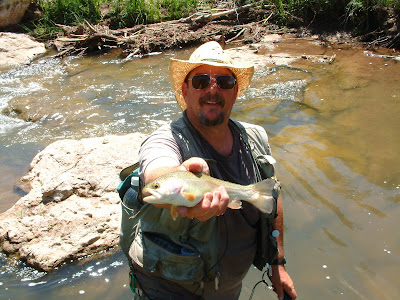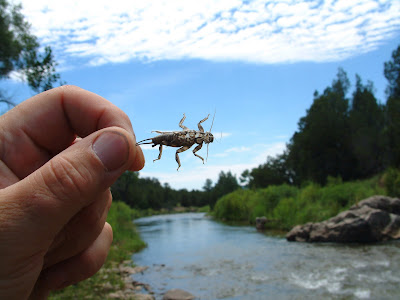Many have seen this lower stretch of river from the road as they motored up to their favorite fishing hole on this famous river’s, quality waters.
And with so many fish to be had upstream, an estimated 70,000 in four miles of public access, many don’t even think about fishing down below.
After all, you’d need a boat and some high water to easily float downstream to those fabled browns.
But that’s just what we did when we set out to explore this lower river on a midsummer expedition to the lower waters of the San Juan River.
The flows on the river this summer were kicked up to around 950 cubic-feet-per-second for a few weeks to supplement lower flows from the Animas River so a minimum flow could be maintained downstream for endangered fish.
Taking advantage of the higher water was drift boat owner, Tim McCarthy, of Albuquerque who is also the author’s brother-in-law. Our guest for the day was Soaring Eagle Lodge owner, Larry Johnson, who frequently guides on the lower river and was happy to be taken fishing for a change.
Johnson noted that during higher flows the lower river is easier to navigate and the fish less spooky and more spread out.
Johnson was cautiously optimistic about our chances for success but sure seemed to be grinning a lot.
We put the drift boat in at the state game and fish department ‘s access point just below the town of Navajo Dam, off San Juan County Road 4277, next to the Rainbow Lodge.
We then took the truck and trailer downstream to the game and fish’s “take out” area just above the Hammond diversion dam.
The take out can be found by taking a right onto a dirt road at the top of a hill just off State Road 511 about a half mile shy of U.S. 64. The road is unmarked save for a skinny green post, bearing a thin, red placard with the numbers 5367, in white, running down it.
One might want to familiarize themselves with the area first on Google Earth, then inquire at a fly shop for local directions and finally do some scouting around before hauling a trailer down there.
The unimproved, dirt road may be impassable when wet and is steep and rutted at some points.
After dropping off the truck and trailer we climbed into our second vehicle and headed back upstream to begin our day-long trip.
We’d lucked into incredible weather as the day began cool and overcast after a week-long, record breaking, heat wave had gripped the area.
The monsoon season was now just beginning, it had rained the night before and it was forecast to do the same again later today.
Johnson suggested we rig up one of his green, woolly boogers sporting rubber legs, a cone head and a trailing hook. He said just chuck it over towards the banks and strip it back with a series of short, quick retrieves.
This proved to be the fly and the technique for the day as we didn’t see a rising fish or a good hatch the entire float.
Swapping off on the oars, we all took turns chucking the green monsters at the ledges, edges and green water, producing attacks from a steady supply of eager brown trout.
It was exciting to see from the vantage point of the boat, the lure threading its way through then water and then the flash of a fish as it came out of hiding to attack it.
We caught a steady supply of browns in a variety of sizes, verifying what game and fish department surveys by electro shocking had already proven, a lot of healthy, brown trout live in these lower waters.
“There’s no doubt about it, there’s some good sized fish down there,” says Marc Wethington, the state Department of Game and Fish’s fisheries biologist stationed on the river. “And they don’t get the pressure you see upstream.”
And that resulted in some great acrobatic displays as many a surprised brown jumped and fought like one might normally expect from a Rainbow trout.
The trip downstream took about six hours with some brief rain showers and overcast conditions during the morning and then sunny and much warmer during the afternoon.
We were well equipped with raincoats, wide-brimmed hats, sunscreen, insect repellent and plenty of cold water and snacks, thus, we didn’t suffer much.
We discovered the river flows through some spectacular country as we passed through canyons hemmed in by towering sandstone cliffs, shot through with layers of faded red and tan rock.
Overhead crows, buzzards, eagles and hawks circled and cried.
At other times we found ourselves hemmed in by thick rows of pale, green and very thorny, Russian Olive trees. Here the bugs seemed thick and the air alive with their buzzing.
As the rookie driver on board, I was constantly warned to stay away from the bank and its thorny trees.
At one point I was also scolded for letting the boat do a lazy, midstream, doughnut as I peered up at the beautiful banks of fluffy, flat bottomed clouds overhead.
Just goofing around, like a kid in an inner tube.
We then came across the idyllic, riverfront home of Abe Chavez, founder of the legendary Abes Motel and Fly Shop at Navajo Dam.
And around another corner we discovered a pretty, little, red and white trimmed, ranch house with a wide expanse of green lawn and a “for sale” sign posted out front.
That got us all buzzing.
The river continued past a pasture stocked with cattle and horses and a grove of shady cottonwoods under which sat a couple of old kitchen chairs and a forked stick stuck in the sand.
Someone’s own, backyard, fishing hole.
What a life, we all agreed.
There were spots that begged further investigation but down here you don’t drop anchor or get out of the boat for fear of trespassing on someone’s land, and maybe, getting shot at, Johnson warned us.
It’s a good policy designed to ensure good relations with the neighbors, he says.
We continue to fish and float, picking up a bruiser hidden behind a log lashed to pile of old automobile grills buried in the bank for erosion control. A dog rushes to the bank growling and barking excitedly as we reel in yet another monster brown.
And then we’re there, in the long slow water leading up to the diversion dam, alerted to its location by the big rock in the middle of the river and an island behind it that splits the current in two.
Johnson warns that we don’t want to miss the take out hidden amongst the thick trees or we might get swept downstream where we’ll have hell to pay dragging the boat back upstream, by hand, in the extremely cold, water.
We find it and bury the nose in the sandy bank, jumping out and slapping high fives all around, it had been an excellent day on the water, with great company and even better fishing.
Back at Cottonwood Campground as we sit under the picnic shelter, guzzling cold beers and grilling fat t-bones, our elderly neighbor stops by to inquire about our luck that day.
I showed him the pictures and he exclaims “Where’d you get those.”
All I can do is smile and say “downstream.”

























